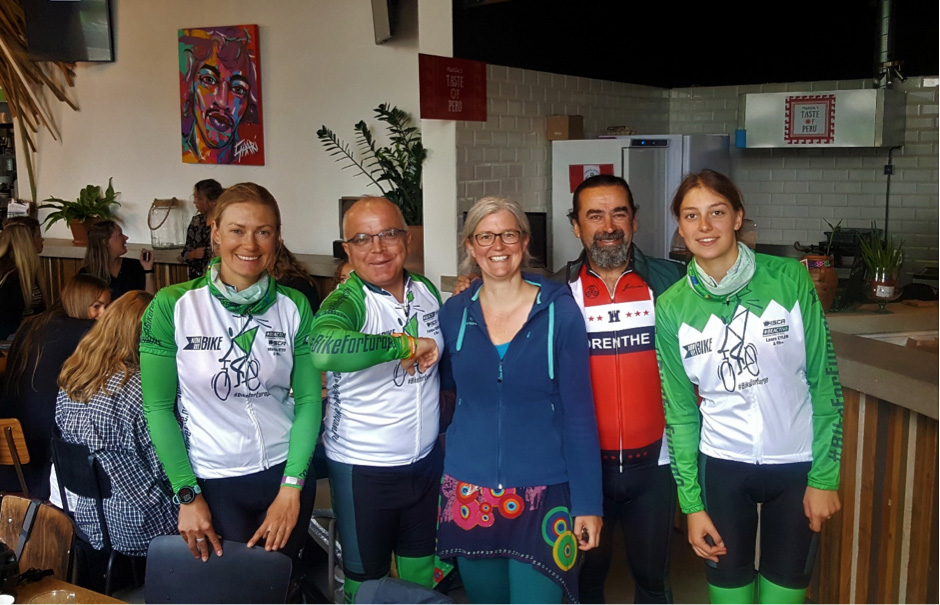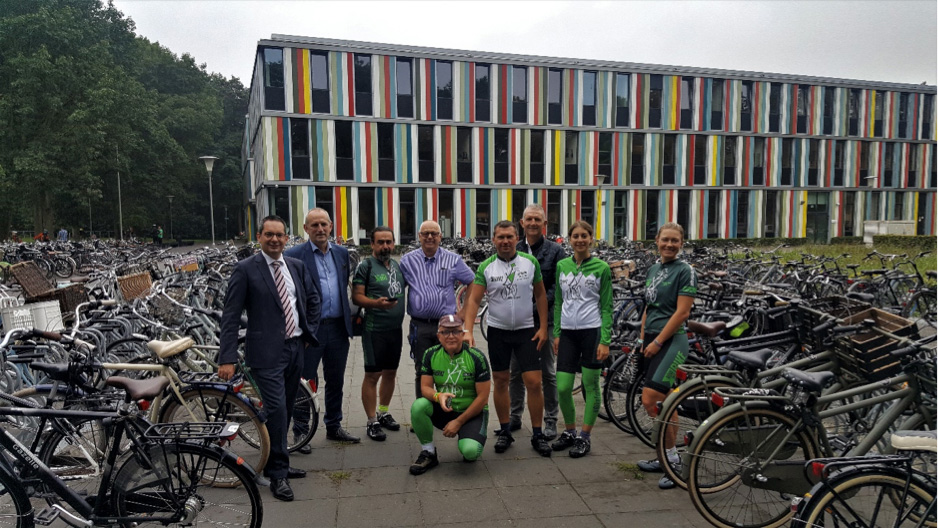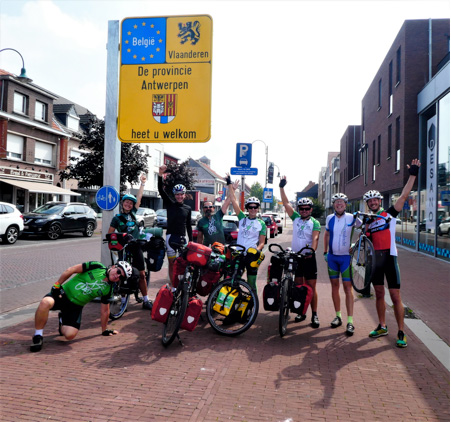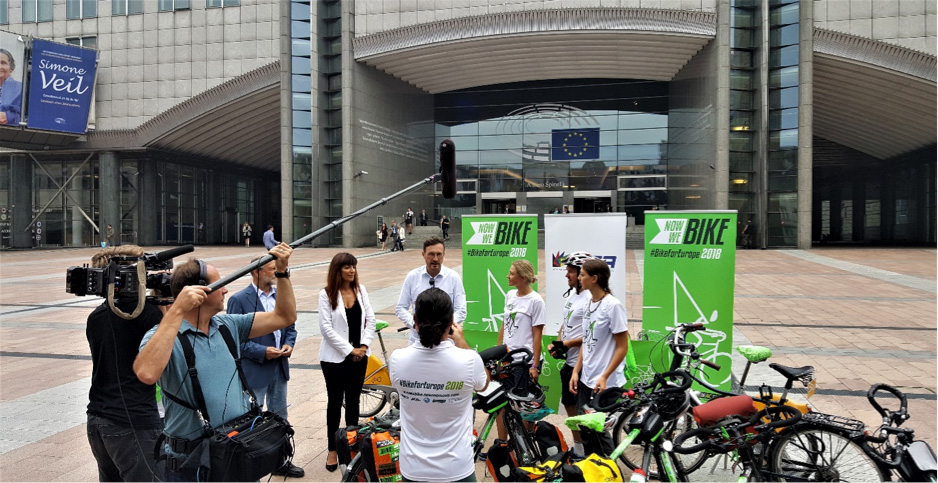Cycling education in the Netherlands and progress for cyclist in Brussels
07/09/2018The North Team’s journey continues as they cycle from the Netherlands to Belgium, where politicians are opening both their doors and their ears to cycling advocates like ourselves!
3 September – Breakfast with an expert

The North Team got up early in the morning and left s’Hertogenbosch behind in order to make it to Tilburg in time for breakfast and coffee with Angela van der Kloof, a Sustainable Mobility Consultant from Mobycon.
While we enjoyed our tea and coffee we picked up the conversation where we had left it on the previous day in Arnhem, and shared opinions, ideas and philosophies about different approaches towards cycling around the world. Our Turkish #BikeForEurope North Team members Adnan Cangir and Feridun Ekmekci shared the challenges the face in regards to moving cycling forward in their own country. The challenges compared to the Netherlands could not be any more disparate. Whereas nearly everybody has accepted the bicycle as a sustainable, cheap and active way to move from one place to another in the Netherlands, Turkish cycling advocates still have a long way to go to establish the bicycle as an accepted, rather than laughed at, way to move around the city.
The Dutch cycling philosophy, the political support and the well designed, people focused - rather than car-centred – infrastructure, constantly reminds us that this way is definitely the right way going forward. If people want to create happier and healthier citizens in an environmentally friendly but more efficient world then the bicycle is the correct tool for this!
As we saw in Arnhem it is so easy and convenient for people to commute to the city by train, and then switch directly to a free rental bike which will be returned after the day in the office is over and people are ready to go back home. Cycling has to be easy, cheap, fast and efficient in order to get people out of their cars and into the saddle.
After the meeting we got back on the road towards Hoogerheide. It was close to cycling nirvana! Good, smooth roads and bicycle lanes all the way, perfect temperatures and a great mood amongst the team. A great advertisement for how cycling is both fast and fun!
We briefly crossed the border into Belgium before re-entering Dutch territory. We were lucky that there have been only a few rain drops since the journey commenced. During the ride we stopped at a milk farm where we had a glass of organic milk and the chance to talk to the local farmer. It was an interesting – and tasty - experience!
After 92.7 km in the saddle we finally arrived at our final destination for the day, the Municipality of Woensdrecht. We spent the night in a former monastery which is now used to accommodate travellers. It is especially bike-friendly and creates an atmosphere similar to a school or college campus… just without the teachers!
Looking forward to the adventures tomorrow holds…
4 September – Woensdrecht shows why it is a UCI Bike City
Today our route went from Hoogerheide via Antwerp to Brussels. In the morning we went to visit Zuid West Hoek College, which is a vocational school for 12 to 16 year olds with several different career options to choose from – mechanics, cooking, technical skills and also cycling, where they learn everything about bikes, how to fix them and assemble them as well.

When we arrived at the school Steven Adriaansen, mayor of Woensdrecht, Piet Antonissen, director of the school as well as Jan Prop, advisor to the Municipality and an international cycling event organiser, were already waiting for us.
As an introduction we were shown a short movie about the school and the municipality, which was awarded the UCI Bike City label in 2017.
Furthermore, we had an opportunity to see the school from inside, drop-in to lessons and to visit the five acres of land surrounding the facility, which are solely there to allow people to train and improve in all aspects of cycling. The facilities range from streets paved with asphalt and cobblestones, to dirt roads with water obstacles, to jumps and fallen tree trunks! The area offers everything that a cyclist’s heart could wish for.
This school is different from others because it provides a speciality for students, and puts cycling at the centre of their physical education curriculum.
After lectures students can take part in free lessons outside of the regular curriculum to train and improve their cycling skills. We spoke with one of the teachers, who said that the number of students taking up this offer can differ – some days he teaches big groups of around 40 pupils, while on other days there might be only 15. Maybe the weather has something to do with the attendance…
Students can participate in races as well. They have already travelled to Canada and South Africa, and did so with money they raised by themselves. Students carry out voluntary work both in and outside of school, and those who know how to cook and bake sell their delicious goods within the municipality to collect money for their trip. Extra cycling lectures are offered for free too.
After the very insightful visit we took off towards the Capital of Europe, Brussels, and were escorted over the border by two aldermen from Woensdrecht. On our route we got to see the industrial side of Belgium, as we covered about 82km today, most of it in Belgium territory. Dominik had some bad luck… with lucky timing! Within the last 2km before reaching the hotel both of his tires got punctured. He pushed his bike to the hotel where he could replace the tubes with new ones in relative comfort at his own pace.
Let’s get ready to meet the decision makers in the European Parliament tomorrow!

5 September - #BikeForEurope goes EU
After enjoying the beautiful bicycle lanes and spaces for cyclists in the Netherlands, the team immediately noticed a difference in the quality of cycling infrastructure upon crossing the border into Belgium. The roads are very narrow and there is a lot of traffic! In the Netherlands, separate cycling paths are built away from the roads, but the infrastructure in Brussels is different as the cycling lanes are often small strips on the street alongside the cars. In some places cars park on cycling paths which forces the cyclists to enter traffic flow alongside motor vehicles, which results in safety risks.

However, there are a lot of people putting effort in to change this, and progress is being made to make Brussels a more cycling friendly city. Today we met with Michael Cramer, Member of the European Parliament and father of the Euro Velo 13, the Iron Curtain Route, Marisa Fernandez Esteban, Deputy head of the sport unit at the European Commission, and Brussels Minister for Mobility and Public Works, Pascal Smet, with whom we went for a ride and who showed us bicycle paths around the city which were built due to his initiatives. We also saw multiple new spaces under reconstruction, which will be exclusive spaces for pedestrians and cyclists. It seems like humans are slowly recapturing the streets of Brussels!
New signs have also been placed on roads, which shows that cars must pay attention to bicycles and share the road. It was very nice to see these achievements and the process set out in future plans. Another sign indicates intersections where cyclists are allowed to turn right while cars still have to wait at the red light.
After the ride we had an opportunity to walk around the city, to see the Grand Palace, the Manneken Pis, the Royal Palace of Brussels, Brussels Town Hall and many more sights...
It was a very interesting and insightful experience to tour around the city with Brussel’s number one cycling advocate, and to get to know more about the barriers and troubles in the fight for safer street space for cyclists.
Tomorrow we venture back into the Netherlands, where we will visit Maastricht for a brief stay before heading on to the Ladies Bike Festival in Sittard.

